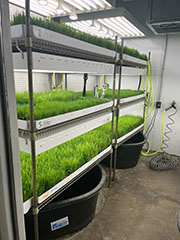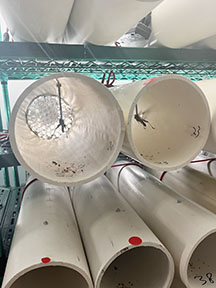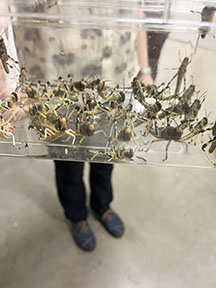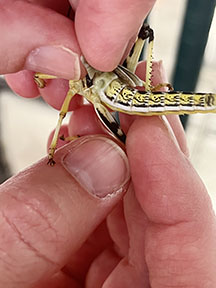 This is the 4th in a series of feature stories on environmental topics by Knight Center students who attended the 2025 Society of Environmental Journalists conference.
This is the 4th in a series of feature stories on environmental topics by Knight Center students who attended the 2025 Society of Environmental Journalists conference.
By Julia Belden

Julia Belden
Journalism – environmental and science journalism in particular – demands from its practitioners a curiosity that often lands one in unusual places.
Out of a myriad of mini-tour options at the 2025 Society of Environmental Journalists conference in Tempe, Arizona, I chose to visit the laboratory facilities of the Global Locust Initiative.
Apparently, attracting conference attendees to visit a basement lab full of locusts was a tough sell.
Of the hundreds of environmental journalists swarming Arizona State University’s campus for the week, I was the only one to attend this insect-themed tour.
It’s a shame, really. Despite their abundance, variety, and ecological and economic importance, insects rarely inspire thoughtful, nuanced press coverage.

Locust meet & greet: a dream for an animal nerd like me!
Here in the United States, most people are familiar with locusts only in Biblical terms. (Fun fact: it’s thought that the Moroccan locust, Dociostaurus maroccanus, is responsible for the swarms depicted in the Old Testament.)
But in the Global South, locusts swarms can cause catastrophic damage to agriculture – so much so that in 2019-21 desert locust (Schistocerca gregaria) swarms landed on a United Nations list of global disasters.
“Locusts don’t attack people directly, they don’t spread disease. The thing that makes them incredibly dangerous is their voracious appetites,” research scientist Rick Overton tells me as we prepare to enter the lab.
Along with ASU professor Arianne Cease, Overton co-directs the Global Locust Initiative, leading a team of undergraduate and graduate student researchers and collaborating with stakeholders from 40 countries to develop strategies for locust management.
“We affectionately call it ‘Hoppertown,’” Overton says of the laboratory, which is home to tens of thousands of locusts, representing three to six species from around the world, depending on research needs.
The lab adheres to strict standards set out by the U.S. Department of Agriculture’s Animal and Plant Health Inspection Service (USDA APHIS).
Waste produced inside the lab is frozen in a large freezer for three days, then incinerated to eliminate the possibility of invasive locust eggs making their way outside.
Staff and visitors must undergo a locust check before leaving the facility, ensuring no stowaways manage to sneak out in a jacket sleeve or hood.

A dash of science humor adorns the door to the flight chamber.
Cease and Overton introduce me to the lab’s student staff, who’ve graciously come into work on a Saturday before finals week to share their work with a tour they’d likely imagined would consist of more than one guest.
My first locust lesson: What we call “locusts” are just a special type of grasshopper.
“There’s maybe like 18-20 species of locusts – depending on who you ask – out of thousands of species of grasshoppers,” Overton says.
What sets locusts apart is their “phenotypic plasticity” – the ability to completely alter their physiology, behavior and even their color based on certain environmental triggers.
This is what causes the migratory swarming behavior that is so dangerous to crops and is a large focus of the Global Locust Initiative’s research efforts.
Projects range from exploring the causes of phenotypic plasticity and locust swarms – “very nerdy fundamental biology,” as Cease calls it – to applied science of locust management utilizing nutritional ecology and biopesticides.
The staff show me each of the lab’s four environmental chambers, which resemble restaurant-style walk-in coolers.

Shelves of wheatgrass line one of the lab’s four environmental chambers
The first chamber is dedicated to growing wheatgrass, which, along with romaine lettuce and wheat bran, makes up the locusts’ diet.
Sawyer Caruso, the undergraduate student in charge of all things grass-growing, tells me about the process that takes a couple of weeks from seed to locust-ready grass.
(Yes, it’s the same wheatgrass you can find at your local juice bar.)
The lab’s locusts devour three-and-a-half cafeteria sized-trays of the bright green grass per day.
While it may not match the meal options of wild locusts, this “captivity diet” allows the staff to raise healthy locusts and tweak their diets for experimental purposes.
“A lot of the experiments we’re doing here allow us to sort of ask a locust – certain species, certain stage of their life – ‘what do you want to eat?’ and also, Olympic athlete style, feed them different diets and see how well they can perform, especially looking at different behaviors that make them difficult to manage,” says Overton.
One of those behaviors is the impressive flight ability that enables swarming locusts to traverse continents in search of food.
Inside another environmental chamber, the researchers test locust flight endurance.

Miniature wind tunnels contain locusts in flight.
Stacks of horizontal PVC pipes, each a miniature wind tunnel, line one side of the chamber.
A few of the pipes are occupied by adult locusts, attached to small rods by a magnet glued to the back of their exoskeleton. (The researchers assure me this doesn’t hurt them.)
Syeda Mehreen Tahir, a biochemist and Ph.D. candidate, examines how the flying locusts perform in relation to the make-up of their diets and the presence of a fungus, Metarhizium, a biopesticide that offers one solution for controlling locust outbreaks.
The advantage to Metarhizium is that it doesn’t present health risks to humans, unlike chemical pesticides.
Unfortunately, the fungus is slow-acting, making it an unattractive option for farmers in the midst of a locust swarm, Tahir says.
A key to speeding up the process may lie in locust nutrition: The researchers found a connection between high-protein diets and fungus susceptibility.
Increasing the amount of protein in locusts’ diets may make them more vulnerable to fungal infection.
Only adult locusts have wings. However, lack of flight capability doesn’t stop youngsters from migratory behavior.
The next chamber houses the “marching arena,” a circular tub filled with colorful locusts on the move.
Neema John, another Ph.D. candidate, studies marching locusts and their dietary preferences. She found that marching locusts tend to prefer high-carb diets vs. high protein diets.

Locusts in their brightly-colored gregarious phase.
The high-carb diets help the juvenile locusts stock up on lipids that they can use for energy as adults, John tells me.
The final chamber on the tour is dedicated to housing gregarious locusts.
Before we head in, Cease and Overton hand me a face mask – not, as I assumed, to prevent a rogue insect from flying in my mouth or nose, but to protect me from exposure to locust dander, which can apparently cause hay fever in some humans. (The more you know!)
Enclosures filled with locusts of all life stages line the walls. Overton reaches through a sock-like apparatus in one of the containers and retrieves a locust.
He shows me how to hold it, gently gripping the hind legs.
The locust calmly regards me with large, dark eyes – it’s almost hard to imagine the somewhat goofy-looking creature as a natural disaster.

Locust “ears” – called tympanal organs – are located on their abdomens. The circular, somewhat translucent structure (near the tope of the image) resembles a human eardrum.
“Locusts are a major global challenge – they’re highly complex. It’s maybe easy to look at them and say, ‘Oh, it’s just like an insect. We can come up with a quick solution,’ but that’s really not the case,” Cease tells me.
Climate change adds additional difficulties to locust management. An increase in severe weather events results in more uncertainty in locust swarm predictions, while changing environmental patterns push locusts into new regions – including the U.S.
As we wrap up my tour with a discussion of the locust’s predators, I can’t resist asking, “Have you guys ever eaten one?”
Cease has “covered them in chocolate and served them at events,” Overton laughs.
Cease adds, “They’re very tasty — I like to bake them with a little bit salt and oil. They’re tasty like that, but when you dip them in chocolate, they kind of taste like toffee.”
